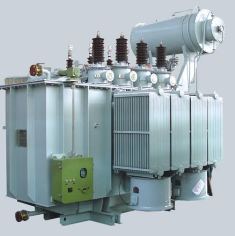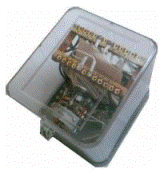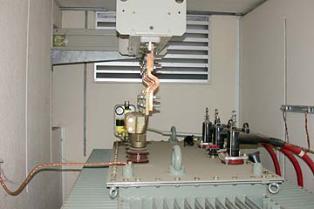How are power transformers protected
For power transformers with a high voltage winding greater than 1000 V relay protection against the following types of damage and abnormal operating modes:
1) multiphase faults in the windings and their terminals,
2) internal damage (turn a short circuit in the windings and "steel fire" of the magnetic circuit),
3) single-phase earth faults,
4) overcurrent in the windings due to external short circuits,
5) overcurrent in the windings due to overload (if possible),
6) lowering the oil level.
When carrying out transformer protection, it is necessary to take into account some of the characteristics of its normal operation: magnetizing current when the transformer is energized, the effect of the transformation ratio and the connecting circuits of the transformer windings.
For protection against multiphase faults in the windings and terminals of transformers of capacity 6300 kVA and above, operating independently, of capacity 4000 kVA and above, operating in parallel, and of capacity 1000 kVA and above, if current interrupt does not provide the necessary sensitivity, overcurrent protection has a time delay of more than 0.5 s and no gas protection, longitudinal differential protection with circulating currents operating at disconnect switches power transformer without time delay.
Characteristics of differential protection of transformers compared to differential protection of generators, lines, etc. is the inequality of the primary currents of different windings of the transformer and their mismatch in the general case in phase.
To compensate for the phase shift of the currents secondary windings of current transformers, installed from the star of the power transformer are connected in a delta, and the secondary windings of the current transformers installed on the delta side of the power transformer are connected in a star. The compensation of the inequality of the primary currents is achieved by the correct selection of the transformation ratios of the current transformers.
When it is impossible to choose the transformation ratio of current transformers in such a way that the difference in the secondary currents in the arm of the differential protection is less than 10% (since current transformers have a standard value of the transformation ratio), when performing protection, differential relays of the RNT type are used to compensate for the inequality of the currents, less often equalizing transformers and autotransformers.
If longitudinal differential protection is not provided (as a rule, for single operating transformers with a capacity of less than 6300 kVA and for parallel operating transformers with a capacity of less than 4000 kVA), then in these cases a current interruption without a time delay covering part of the transformer winding.
Longitudinal differential protection is used in operating and reserve transformers for auxiliary needs of thermal power plants; power failure is allowed at 4000 kVA power.

The simplest scheme for implementing longitudinal differential protection is interrupting the differential current, which is used in cases where it meets the sensitivity requirements. If this condition is not met, an RNT type relay is used in longitudinal differential protection.
 RNT relay has saturated transformers (NT), providing a reduction in currents due to magnetizing inrush currents and unbalance currents occurring during the transient process at external short circuitsand compensates for the unevenness of the secondary currents of current transformers.
RNT relay has saturated transformers (NT), providing a reduction in currents due to magnetizing inrush currents and unbalance currents occurring during the transient process at external short circuitsand compensates for the unevenness of the secondary currents of current transformers.
Transformers controlled by load voltage or multi-winding transformers with multiple supply windings, when due to high unbalance currents in the relay at external short-circuits, protection with saturating transformers does not provide the required sensitivity, differential protection is provided with stop and installation of DZT type relays or their replacement.
The protection is calculated in advance for the case of using the relay without stopping. If it turns out to be insufficiently sensitive, use a relay with the minimum number of brake coils that provide the required sensitivity. The operating current of the longitudinal differential protection must be distinguished from the magnetizing and unbalance currents.
Protection of power transformers from internal damage
For protection against internal damage (winding damage accompanied by gas release) and against a drop in the oil level of transformers with a capacity of 6300 kVA and more, as well as transformers with a capacity of 1000 — 4000 kVA, which do not have differential protection or interruption, and if the overcurrent protection has a time delay of 1 s or more, a gas protection is applied with an action on the signal at low and on shutdown at intense gas formation... The use of gas protection is mandatory for internal transformers with a capacity of 630 kVA and more, regardless of the presence of other fast-acting protections.
Gas protection is installed on transformers, autotransformers and oil-cooled reactors with expanders and is carried out using float, paddle and cup gas relays. Gas protection is the only protection of transformers against the "steel fire" of the magnetic circuit, which occurs when the insulation between the steel sheets breaks.
Gas protection is permitted for both low and high gas signal on differentially protected or tripping transformers, without switches, and in an indoor workshop rated at 1600 kVA or less with supply side short circuit protection.

Protection of transformers from single-phase earth faults
For protection against single-phase earth faults of step-up transformers with a capacity of 1000 kVA and above connected to networks with high earth fault currents, as well as step-down transformers with an earthed neutral, maximum zero-sequence protection against external earth fault currents is provided , acting on trigger.
Due to the widespread use of transformers 6 — 10 / 0.4 — 0.23 kV with a delta-star connection scheme, with a firmly grounded neutral on the 0.4 kV side, in which the reactance and active resistance of the zero sequence are equal to the resistances of the positive sequence, the single-phase short-circuit currents on the 0.4 kV side will be equal to the three-phase short-circuit currents during short-circuits at or near the transformer terminals.
At these currents, the maximum current protection installed on the HV side can work with sufficient sensitivity, and it is permissible not to install protection in the neutral part of the transformer, leaving it only to protect the transformer with a basic block diagram of the transformer with a long bus channel… The tripping current of the protective relay against single-phase short-circuits of short-circuited transformers on the 0.4 kV side (the protection is connected to the current transformer in the bullet wire in the neutral part of the transformer) must be for connecting the windings:

where kn-reliability factor equal to 1.15-1.25; kn is a coefficient taking into account the overload and equal to 1.3 for oil and 1.4 for dry transformers in the absence of design data, what is the return coefficient of the relay, where is the transformation coefficient of the current transformer, Aznominal t — nominal current of the power transformer.
In networks with low earth currents, protection against single-phase earth faults with tripping action is installed on transformers, if such protection is available in the network.
Protection of transformers from overcurrent in the windings caused by external short circuits
To protect step-down transformers against currents caused by external short-circuits, overload protection is provided without tripping or with starting from the undervoltage relay operating to open the breaker. Due to the low sensitivity, overcurrent protection without starting from the undervoltage relay is used only on transformers with a capacity of up to 1000 kVA.
To protect step-up transformers from external short circuits. maximum overcurrent protection with voltage release relay or residual overcurrent protection.
Undervoltage relay starting overcurrent protection for multi-winding step-up transformers turns out to be quite complex (due to the presence of several sets of undervoltage relays) and insufficiently sensitive to current. In this case, residual overcurrent protection... The latter is recommended for step-up transformers with a capacity of 1000 kVA and more with a solidly grounded neutral.
If the step-up transformer protection does not provide the required sensitivity, then current relays with suitable generator protection can be used to protect the transformers.
In some cases, negative sequence overcurrent protection is used to protect power transformers, which is easily combined with similar protection of generators.
In multi-winding transformers fed from several sides, directional protection is provided to ensure selectivity.
For overload protection of several transformers operating in parallel with a capacity of 400 kVA and more, as well as in the case of separate operation and the presence of an automatic transfer switch, a single-phase overcurrent current protection acting on the signal is provided.
In unattended substations, protection with the effect of automatic unloading or tripping of the transformer can be carried out.
